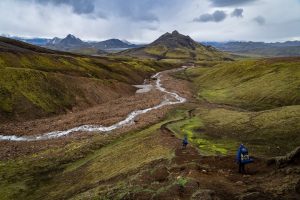Remote sensing refers to the act of recording information about the earth’s surface by the use of sensors attached to satellites. Remote sensing plays a vital role in collecting information over large surface areas, characterizing natural features on the earth, observing and monitoring the earth and objects changes over time, and avail this information for processing and analysis. In remote sensing, The sun is the ultimate source of energy is very useful for illumination. Satellites have imaging sensors used to monitor the earth through imagery collection. Sensors consist of an electronic circuit with optical components that can record reflected electromagnetic radiation from different objects. These imaging sensors can fall into two categories which are active or passive sensors.
Passive sensors measure the energy naturally emitted, and the sunlight is the primary source of energy used. Simultaneously, Active remote sensing systems generate their electromagnetic energy source for illumination to the target and record the backscattered radiation from the target. Passive remote sensors include radiometer, cameras “which can be both passive and active, “and spectrometers, while Active remote sensors include x-ray, radars, and lidars. Remote sensing is beneficial in various fields such as land survey, geography, and earth science disciplines.
Differences
1. Source of Energy
Active remote sensing uses its energy source to illuminate electromagnetic radiation to the target and record the reflected radiation measurement. In contrast, passive remote sensing has to use naturally occurring energy that illuminates the target and reflects the electromagnetic radiation to the remote senor to record the electromagnetic radiation. The primary source of energy in passive remote sensing is sunlight.
2. Time of Recording
Passive remote sensing can only function when the natural energy source is available, i.e., in most cases, the sun is only present during the daytime, limiting the working timeframe. However, active remote sensing can measure radiation anytime despite what time of day, night, or season since they have their energy source, which emits their electromagnetic radiation to obtain a measurement, hence strong capabilities of collecting imagery day and night.
3. Weather Conditions
Active remote sensing is not affected by poor weather conditions since it emits its energy directly to the target with no interference by adverse weather. However, Passive remote sensing is significantly affected by adverse weather conditions like heavy clouds, which may block enough sunlight illuminating the target; hence, remote sensors cannot capture the correct reading of the electromagnetic radiation reflected.
4. Radiation
Active and passive sensors have a difference in electromagnetic radiation and are distinguished by bands and wavelength measurements. Active remote sensing can be characterized by the wavelength of the electromagnetic radiation emitted, while passive remote sensing is distinguished by the number of bands that measure radiation.
5. Imagery
Passive remote sensing is preferred for satellite imagery since it delivers excellent imaging quality through technologies such as hyperspectral and multispectral, unlike the quality delivered by Active remote sensing hence used for aerial photography. Passive sensors are great in technical observation of the earth’s surface.
6. Noise
Active remote sensing has more control of noise originating from the source of the electromagnetic radiation and reflection of the target through control of the injected signal, unlike passive remote sensing, which offers less noise control. The source of energy, primarily the sun, is out of control of the surveyor.
7. Imaging Angles
Active remote sensing allows for shallow look angles that create different target perspectives, giving more accurate readings of the ground object, while passive remote sensing delivers less accurate measurement readings of ground objects due to variation in sunlight affected by weather conditions.
8. Amount of Energy
Active remote sensing requires a large amount of energy to generate adequate electromagnetic radiation for illumination. However, passive remote sensing only requires sunlight to obtain reflection of electromagnetic radiation, to record measurements from the illuminated object.
9. Penetration Capacity
Active remote sensing allows for radiation penetration through vegetation, water bodies, soil, and snow and is excellent in collecting earth surface information and is not hindered by any weather condition; unlike Passive remote sensing, which is excellent at collecting satellite images of the earth and affected by adverse weather conditions.
10. Satellites
Active remote sensing relies on the latest technology models of satellites which may prove very costly and complex to operate and maintain, while passive remote sensing uses radiation signals from old satellites that are easy to operate.
11. Areas of Survey
Passive remote sensing focuses on land use, land cover analysis, and small-scale mapping requirements. On the other hand, active remote sensing targets areas like flooding, geological data, volcanic eruptions, earthquake disaster management, soil study, and mapping of mineral zones.
12. Survey Data
Active remote sensing requires a surveyor to cross-verify the vast amount of field data survey and better depth control of fake signals transmitted, while passive remote sensing requires the surveyor to record a naturally occurring field.
13. Quantity of Data
Active remote sensing can generate large quantities of data from various sources used for generating a detailed interpretation of the earth’s surface, while passive remote sensing has small data sets collected and does not allow for detailed interpretation of information acquired.
14. Time of Data Interpretation
Passive remote sensing allows for quick, efficient, and practical interpretations of data with less computational needs, unlike Active remote sensing, where a large quantity of data is collected and may prove overwhelming to compute, process, interpret and present.
15. Orbits Followed
Active remote sensing revolves around near-polar orbits and has high accuracy in both lateral and longitudinal directions. Passive remote sensing follows geostationary orbits positioned over exact location and time.
16. Electromagnetic Radiation Energy
Active remote sensing transmits and measures the electromagnetic radiation emitted and reflected, while passive remote sensing only measures the reflected radiation from the target.
17. Temperature
Active remote sensing can measure temperature independent of the light source or changes in the weather conditions, but passive remote sensing is sensitive to weather conditions which may affect accurate measurements of temperature.




bfitdoon
27 Oct 2021M.Sc. in Seed Science and Technology Seed Science & Technology, students are taught the growth and the formation of seeds from the process of fertilization of the egg cell on the maternal plant as long formation of new plant from the seed takes seed. M.Sc. in Seed Science and Technology is best college m.sc. in seed science and technology in dehradun a two years long course which is divided into four semesters. There are many colleges which provide this course and one of them is BFIT Dehradun. Masters degree in seed science & technology The syllabus of the M.SC Seed science and technology is split into four semesters spread over a span of 2-years. The syllabus of the route is split into diverse subjects and research-based modules that scholars are taught for the duration of the course in their post-graduation. The syllabus covers all of the aspects related to seed science and technology so as to provide a holistic know-how of the concern to the undergraduate students.The details concerning the syllabus of the course are cited under so, as to provide a reference to the candidates.